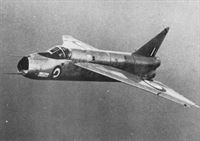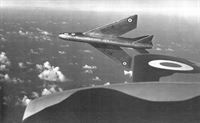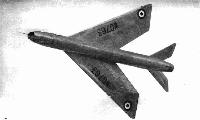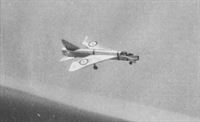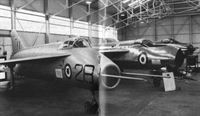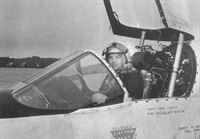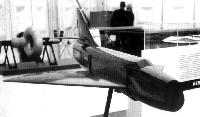
Варианты
- Short - SB.5 - 1952 - Великобритания
- English Electric - P.1 - 1954 - Великобритания
- English Electric / BAC - Lightning - 1957 - Великобритания
- English Electric / BAC - Lightning T.4 / T.5 - 1959 - Великобритания
English Electric Lightning
В 1963 году образовавшаяся "British Aircraft Corporation" занялась дальнейшей модернизацией перехватчика English Electric Lightning, принятого на вооружение в 1960 году. Его появление возвестило начало новой эры для британских ВВС. Инициатором этого проекта стал В. И. В. "Тэдди" Питтер. Благодаря его дальновидному предложению фирма "English Electric" получила в еще 1947 году контракт на постройку экспериментального сверхзвукового самолета P.1A. Этот самолет с двумя бесфорсажными турбореактивными двигателями Bristol Siddeley Sapphire впервые взлетел 4 августа 1954 года, а в дальнейшем в одном из полетов превысил скорость звука. Были собраны три экземпляра: два для летных испытаний и один для наземных испытаний на прочность. Эти самолеты отличались характерными эллиптическими воздухозаборниками.
<...>
- Описание
Фотографии
-
АвиаМастер 2006-07 / К.Логинов - Первый и последний... /Монография/
Самолет P.1A - предшественник BAC "Лайтнинга" без носового конуса, РЛС и вооружения
-
Aeroplane Monthly 1982-11 / P.Jarrett - Grapevine
Регистрационный номер: WG760 [30] English Electric P.1 WG700 was refurbished at RAF Binbrook in only six weeks. After a long spell exposed to the elements at Henlow it is now to be kept inside the hangars.
-
Aeroplane Monthly 1988-08 / R.Beamont - A flash of silver (1)
Регистрационный номер: WG760 [30] The author lifts the nosewheel of WG760 for the first time, at Boscombe in July 1954.
-
Aeroplane Monthly 1992-01 / R.Beamont - Spinning the P.1
Регистрационный номер: WG760 [30] The author at the controls of the P.1A WG760 on its first flight with the cambered leading-edge wing - Warton, February 15, 1957.
-
Aeroplane Monthly 1988-09 / R.Beamont - A flash of silver (2)
Регистрационный номер: WG760 [30] Roland Beamont demonstrates WG760 at the SBAC’s Farnborough Show in September 1957. It had made its display debut at the 1955 show.
-
Aeroplane Monthly 1988-08 / R.Beamont - A flash of silver (1)
Регистрационный номер: WG760 [30] First flight of the P.1. The author gets the undercarriage away quickly on take-off past Boscombe ATC - August 4, 1954.
The technology demonstrator. View of the English Electric P.1 prototype at Boscombe Down in August 1954. The view shows WG760 during its first flight, in the hands of the Roland Beamont, on August 4, 1954. -
Aeroplane Monthly 1988-09 / R.Beamont - A flash of silver (2)
Регистрационный номер: WG760 [30] The author flying WG760 from Warton soon after returning from Boscombe Down in November 1954.
-
Air Pictorial 1956-09 / J.Stevens - Farnborough 1956
Регистрационный номер: WG760 [30] The English Electric P.1 will not land at Farnborough owing to Security restrictions. It will fly over on the two public days.
-
Aeroplane Monthly 1988-10 / R.Beamont - A flash of silver (3)
Регистрационный номер: WG760 [30] The author flying WG760 on a press day at Warton in 1956. The aircraft has the cambered leading edge wing. The main observable difference between this aircraft and WG763 is the latter’s belly tank.
-
Aeroplane Monthly 1988-10 / R.Beamont - A flash of silver (3)
Регистрационный номер: WG763 [7] Dramatic shot of the author flying the P.1A WG763 at Warton in June 1957, shortly before the aircraft was handed over to the AID and then flown to RAE Bedford for further trials.
-
Aviation Historian 30 / T.Buttler - Struck by Lightning
Регистрационный номер: WG763 [7] The second prototype English Electric P.1, WG763, makes a very low, and no doubt very noisy, pass some time after its first flight on July 18, 1955. Fitted with a pair of Aden cannon in the nose, WG763 also incorporated a bulbous belly fuel tank for the two thirsty (although non-reheated) Sapphire engines, mounted one atop the other.
-
Air Pictorial 1955-10 / J.Stevens - Farnborough 1955
Регистрационный номер: WG763 [7] Second prototype English Electric P.1.
-
Aeroplane Monthly 1988-10 / R.Beamont - A flash of silver (3)
Регистрационный номер: WG760 [30] The author takes a close look at the RAE’s photographic Lancaster’s rear turret in 1956. WG760 is seen here with the cambered leading edge wing.
-
Aeroplane Monthly 1988-10 / R.Beamont - A flash of silver (3)
Регистрационный номер: WG760 [30] Another view of WG760 with the modified wing, taken in 1957.
-
Aeroplane Monthly 1985-02 / R.Beamont - Sing a song of shock-stall (2)
Регистрационный номер: WG760 [30] The P.1 prototype with the later cambered leading edge modification.
The English Electric P.IA, WG 760, progenitor of the Lightning, perhaps the one really outstanding British fighter of the thirty years following World War II. First flown on 4 August 1954, with 'Bea' Beamont at the controls, the twin 8.100lb s.t. unreheated Armstrong Siddeley Sapphire AS8a5-powered P.1A became the first British aircraft to exceed Mach 1 when it reached Mach 1.02 at 30.000 feet, or 692mph on 11 August just six days into flight testing. -
Aviation Historian 19 / K.Hayward - Kill or cure? The view from Whitehall
Регистрационный номер: WG760 [30] Первый экземпляр P.1A в полете
English Electric’s P.1 was originally conceived in response to Air Ministry Specification F.23/49, which called for a supersonic interceptor capable of destroying high-altitude bombers. The P.1A research protoype, WG760, seen here, first flew in August 1954, but by 1957 the government had begun reshaping its defence policy. -
Aeroplane Monthly 1988-08 / R.Beamont - A flash of silver (1)
Регистрационный номер: WG760 [30] The English Electric P.1 single-seat interceptor is powered by two Armstrong Siddeley Sapphires which will probably have afterburning when the P.1 goes into service. It flies faster than sound in level flight without afterburning or any other form of power boosting .
On the same first photo sortie, Beamont shows off WG760’s clean, uncluttered lines. -
Aeroplane Monthly 1988-08 / R.Beamont - A flash of silver (1)
Регистрационный номер: WG760 [30] The author brings P.1 prototype WG760 in for its first air-to-air photo session, at Boscombe Down in September 1954.
-
Мировая Авиация 167
Регистрационный номер: WG760 [30] Даже в раннем варианте - без подфюзеляжного топливного бака и с эллиптическим воздухозаборником - в P.1 угадываются черты будущего Lightning.
The English Electric P.1A prototype, WG760, made its first flight on August 4, 1954, and was the basis for the Lightning, the RAF’s first true supersonic fighter, capable of exceeding the speed of sound in level flight. The Lightning would be one of the few survivors of the radical changes in procurement policy during the 1950s. -
Aeroplane Monthly 1988-10 / R.Beamont - A flash of silver (3)
Регистрационный номер: WG760 [30] WG760 on test from Warton in 1957, fitted with cambered leading edge and extended wingtips as part of the programme leading to the Mks 6 and 53 etc.
-
Aeroplane Monthly 1988-09 / R.Beamont - A flash of silver (2)
Регистрационный номер: WG760 [30] WG760 on its first air-to-air photographic sortie, from Boscombe Down in September 1954. Its original wing planform, with straight leading edges, is clearly shown.
-
Air Pictorial 1956-04
Регистрационный номер: WG760 [30] English Electric P.1А, разработанный в соответствии с той же спецификацией, что и F.D.2, в дальнейшем превратился в истребитель Lightning. Но, несмотря на то, что P.1A и Lightning были очень скоростными, они никогда не использовались для установления мировых рекордов скорости.
Although the English Electric P.1 (P for Pursuit) was first flown by W/C Roland Beamont at Warton, Lancashire, on 4th August 1954, air-to-air photographs (including this one) have been restricted for the past eighteen months. Five prototypes and twenty pre-production P.1As are on order. Power is two 8,000-lb. S.t. Armstrong-Siddeley Sapphire axials. All other data is restricted. WG160 is the first prototype. -
Air Enthusiast 1997-05 / T.Buttler - Early Wing-Swingers
Регистрационный номер: WG760 [30] The English Electric P.1 prototype supersonic fighter to Specification F23/49 photographed on October 10, 1954. ER.110T used F23/49 as a reference point so the five submitted designs might be considered as swing-wing rivals to the P.1.
-
Air Pictorial 1955-12
Регистрационный номер: WG763 [7] This fine action study taken at this year's S.B.A.C. Display by the Shell Film Unit reveals the planform of the Sapphire-powered English Electric P.1. This is the second prototype - WG760 was the first - and is one of five which precede the pre-production order for twenty of these supersonic, single-seat interceptors.
-
Air Pictorial 1957-06
Регистрационный номер: WG760 [30] The P.1A (WG760) is conducting flight trials with a revised wing shape. This photograph shows that extra area has been added to the wingtips.
-
Air Pictorial 1957-08 / R.Cross - P.1B
Регистрационный номер: WG760 [30] P.1A WG760 is shown with the cranked-wing leading edge and inset ailerons which possibly will be incorporated in production machines.
-
Aeroplane Monthly 1992-01 / R.Beamont - Spinning the P.1
Sequence 1: 112kt at 20,000 ft. Sequence 2: 108kt rolling left. Sequence 3: right stick. Sequence 4: spinning. Sequence 5: pitching down. Sequence 6: yawing left. Sequence 7: yawing left, pitching up and rolling left.
-
Aeroplane Monthly 1992-01 / R.Beamont - Spinning the P.1
Sequence 8: the end of the first turn but continuing the spin, rolling left into the second turn - 90kt at 18,000ft, having lost 2,000ft in the first turn.
-
Air Pictorial 1955-10 / J.Stevens - Farnborough 1955
Регистрационный номер: WG763 [7] The second prototype English Electric P.1
-
Aeroplane Monthly 1988-08 / R.Beamont - A flash of silver (1)
Регистрационный номер: WG760 [30] The author lands WG760 at the end of its first flight - Boscombe Down, August 1954.
-
АвиаМастер 2006-07 / К.Логинов - Первый и последний... /Монография/
Регистрационный номер: WG763 [7] Первый экземпляр P.1A на пробеге после посадки
Other P.1 features shown below are the gunports and ventral bulge on WG763, and the drooped leading-edge flaps (photo). -
Aeroplane Monthly 1988-09 / R.Beamont - A flash of silver (2)
Регистрационный номер: WG760 [30] One of English Electric’s first publicity photos of the first P.1 prototype, WG760. It appeared in Flight’s issue of August 13, 1954, just over a week after the aircraft’s first flight.
-
Jane's All the World Aircraft 1980 / Encyclopedia of Aviation - Aircraft A-Z - v3
English Electric P.1A.
-
АвиаМастер 2006-07 / К.Логинов - Первый и последний... /Монография/
Регистрационный номер: WG760 [30] -
Aeroplane Monthly 1988-08 / R.Beamont - A flash of silver (1)
Регистрационный номер: WG760 [30] English Electric F23/49/P.1 supersonic research prototype WG760 upon roll-out at Boscombe Down in July 1954.
-
Aeroplane Monthly 1988-08 / R.Beamont - A flash of silver (1)
Регистрационный номер: WG760 [30] WG760 preparing for its first flight. Note the mesh guard over the nose intake.
-
Мировая Авиация 167
Регистрационный номер: WG760 [30] P.1A оснащался двумя двигателями Sapphire AS Sa.5, форсированные двигатели установили позже.
First engine run on the P.1: a “wet start" at Boscombe Down in July 1954. -
Air Pictorial 1957-08 / R.Cross - P.1B
Регистрационный номер: WG763 [7] Other P.1 features shown below are the gunports and ventral bulge on WG 763 (photo), and the drooped leading-edge flaps.
-
Aeroplane Monthly 1988-07 / 1988 UK Aircraft Collections and Museums Guide
Регистрационный номер: WG760 [30] Lightning lineage at Cosford: from front to back, Short SB.5 WG768, English Electric P.1A WG760 and Lightning F.1 XG337.
Другие самолёты на фотографии: English Electric / BAC Lightning - Великобритания - 1957Short SB.5 - Великобритания - 1952
-
Aeroplane Monthly 1988-09 / R.Beamont - A flash of silver (2)
Регистрационный номер: WG760 [30] The author, as chief test pilot of English Electric, in the cockpit of P.1 prototype WG760 at Warton in 1955.
-
Aeroplane Monthly 1992-01 / R.Beamont - Spinning the P.1
Регистрационный номер: WG760 [30] The author at the controls of P.1A WG760 at Warton in 1955, before the aircraft had been fitted with the new cambered wing system.
-
OS 1 / H.Cowin - X-Planes
This 1949 wind tunnel model of what was to become the English Electric P. IA of 1954 provides an insight into the vital part the wind tunnel plays in the transition from drawing board to flyable prototype. While recognisable as a precursor of the RAF's Mach 2 Lightning, the tail unit configuration, along with the low mounted wings, caused severe pitch-up forces at transonic speeds. An item of possible interest to trainspotters is the uncanny resemblance of this model's windscreen to that of the Deltic locomotive built for British Rail by another English Electric Division.
- Фотографии














